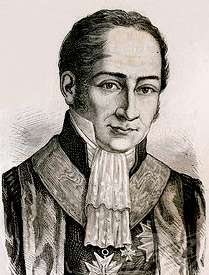Charles Barbier
| Charles Barbier | |
|---|---|
 | |
| Born |
18 May 1767 Valenciennes |
| Died |
29 April 1841 (aged 73) Paris |
| Occupation | Cryptographer |
Charles Barbier de la Serre (18 May 1767 – 29 April 1841) was the creator of night writing.
Charles Barbier de la Serre was a captain in the French Army during the early 19th century. "Ecriture Nocturne" (night writing) was invented in response to Napoleon's demand for a code that soldiers could use to communicate silently and without light at night.[1]
Barbier's system was related to the Polybius square, in which a two-digit code represents a letter. In Barbier's variant, a 6x6 square includes most of the letters of the French alphabet, as well as several digraphs and trigraphs:
| 1 | 2 | 3 | 4 | 5 | 6 | |
|---|---|---|---|---|---|---|
| 1 | a | i | o | u | é | è |
| 2 | an | in | on | un | eu | ou |
| 3 | b | d | g | j | v | z |
| 4 | p | t | q | ch | f | s |
| 5 | l | m | n | r | gn | ll |
| 6 | oi | oin | ian | ien | ion | ieu |
A letter (or digraph or trigraph) was represented by two columns of dots, in which the first column had one to six dots denoting the row in the square and the second had one to six dots denoting the column: e. g. 4-2 for "t" represented by
| • | • |
| • | • |
| • | |
| • |
As many as twelve dots (two columns of 6) would be needed to represent one symbol.
Barbier's system was not a simple encoding of the French alphabet. The system required the user to first encode the standard spelling into a quasi-phonetic rendering. Mellor [2] gives the following example:
Une femme était restée veuve avec trois garçons et ne subsistait que par leur travail (A woman had been widowed with three sons and was provided for only by their work.)
encoded as:
un fam étè résté veuve avec troi garson é n subsistè q d leur travall
Eventually Barbier introduced his concept to the blind at the suggestion of members of the French Royal Academy of Sciences. In 1821, students at the Royal Institution for Blind Youth in Paris assembled to allow Charles Barbier de la Serre to demonstrate his system. The system was favorably received, because the older system of embossed Latin letters with its curves and straight lines was much harder for blind people to understand than the simple patterns of dots. Barbier also provided a system by which the students could write his symbols, using a special writing board and a pointed tool to make the dots.
Louis Braille, who was a boy studying at the institution at the time, was interested in Barbier's method. Braille had suggestions on improving the code, based on (among other things) reducing the number of dot positions from 12 in 6 rows to 6 in 3 rows, which was easier to scan with the fingers, but Barbier, because of his aristocratic manner, felt insulted that a boy had tried to improve his code. Later, Braille transformed night writing, which Barbier had invented, and turned it into a system used to this day: Braille.
References
- ↑ "What is Braille?" (web). American Foundation for the Blind. Retrieved 2008-04-02.
- ↑ Mellor, C. Michael (2006). Louis Braille: A Touch of Genius. Boston, MA: National Braille Press. ISBN 0-939173-70-0.